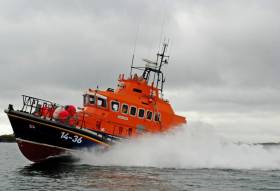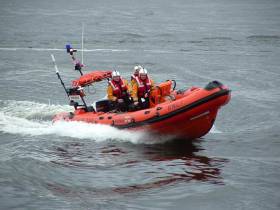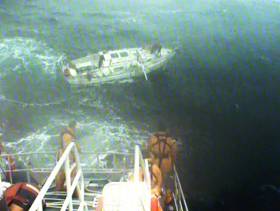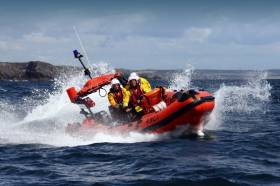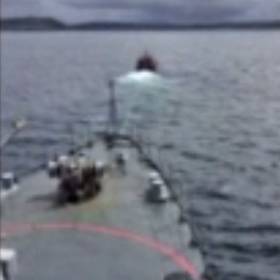Displaying items by tag: Lifeboats
#RNLI - Fethard RNLI assisted a man who got into difficulty off the Wexford coast yesterday evening (Tuesday 23 August) as he attempted to move between two boats.
The volunteer lifeboat crew launched their inshore lifeboat at 9.35pm following a request by the Irish Coast Guard that a man had entered the water at the Coal Yard in Cullenstown.
The lifeboat, helmed by John Colfer and with crew members Thomas Stafford, Finola Foley and Cathal O'Connell onboard, launched immediately from Fethard and proceeded five nautical miles to the scene.
Weather conditions at the time were described as calm with a Force 3 west to north-westerly wind.
The casualty, who was wearing a lifejacket at the time, had been manoeuvring from one vessel to another when he entered the water and got into difficulty. A member of his party who had already come ashore raised the alarm.
Shortly before arriving on scene, the crew received communication from the coastguard that the casualty had managed to swim ashore. On arrival, the lifeboat crew safely transferred the man into the D class inshore lifeboat Trade Winds and administered first aid.
The crew brought the casualty straight ashore at the Coal Yard, where members of the local coastguard unit were also on site. The volunteer crew continued first aid until the arrival of an ambulance that transferred the casualty to hospital as a precautionary measure.
Speaking following the callout, Fethard RNLI deputy launching authority Tony Molloy said: "Every minute counted this evening due to the period the casualty had spent in the water and the external temperature.
"The bar of the lough at Cullenstown can be quite a treacherous to manoeuvre in darkness, so the knowledge and skill set of the crew who know the area and the manoeuvrability of the D class inshore lifeboat was essential in getting to the scene where the crew was able to respond rapidly.
"We would like to commend the casualty for wearing his lifejacket and the member of his party who raised the alarm when they started to experience problems. We wish them both well following their ordeal."
Molloy added: "Tonight’s callout was a fine example of good team work with our crew putting their training and skills into practice working alongside our colleagues in the local Irish Coast Guard unit."
This weekend sees the inaugural Waves Music Festival to raise funds for Fethard RNLI to secure a new inshore lifeboat, a major boost for which they received recently from host venue Loftus Hall.
Three Calls In 24 Hours For Donaghadee Lifeboat Volunteers
#RNLI - Donaghadee’s RNLI lifeboat Saxon put to sea three times in 24 hours during a busy weekend keeping aircraft passengers and pleasure sailors safe around the North Down coast.
The first call came at 5.30pm on Friday (19 August) when an inbound aircraft heading for George Best Airport reported technical problems and HM Coastguard requested a launch in keeping with established air emergency procedures. These ensure a swift response from lifeboats should an aircraft be forced to ditch at sea.
The Donaghadee lifeboat made its way at top speed of 25 knots to a designated location along the flight path. However, the aircraft was able to land without incident and the lifeboat returned to station. The operation also involved Bangor and Larne RNLI crews.
On Saturday morning (20 August), the Donaghadee crew launched around 11am after a report that a 20ft yacht had run aground on rocks at Craigbrain, near Ballyferris caravan park.
At the scene, the crew launched the smaller inflatable lifeboat in difficult conditions with a 1.5m swell, but established that no one was aboard the grounded catamaran.
Safety advice was given from coastguard officers on the shore and it was decided to let the incoming tide lift the yacht off the rocks to allow for a safer retrieval by the owner.
The crew had just returned to the boathouse at 12.30pm when the coastguard requested another launch. This time a 31ft yacht, with three people aboard, had reported an engine fire east off Burr Point near Ballyhalbert.
On the way, the lifeboat crew encountered treacherous seas with 5m waves, making for an uncomfortable passage.
Once on scene, the crew of the yacht confirmed they heard automatic fire extinguishers firing in the engine room. The lifeboat approached, secured a towline and set course for the difficult passage back to Donaghadee.
The stricken yacht was brought alongside and berthed in the harbour, where two appliances from the Northern Ireland Fire and Rescue Services attended as a precaution.
The lifeboat and her crew were back at sea on Sunday morning to conduct a regular training exercise.
Donaghadee RNLI deputy coxswain John Ashwood said: ”It has been a quiet summer for the crew so far but this weekend was one of the busiest 24-hour periods we have experienced in quite some time. We are always ready to respond if lives are in danger at sea.”
Seven Callouts In Five Days For Lough Ree Lifeboat
#RNLI - Lough Ree RNLI's volunteer lifeboat crew had one of their busiest periods ever in the last week, receiving a total of seven callouts over five days to assist people on and around Lough Ree.
The first callout came from the Irish Coast Guard shortly 2pm on Tuesday afternoon (16 August) to reports of a 35ft steel cruiser, with six onboard, aground between Athlone Lock and Clonmacnoise.
Later that afternoon, the crew was again called to assist a man aboard a 25ft sailing yacht aground near Barley Harbour on Lough Ree.
In both cases, the recovery was straightforward and no injury to crew or damage to vessels was incurred.
On Saturday (20 August), the lifeboat crew received three calls to assist vessels in difficulty amid very wet conditions with strong winds.
The first call came shortly before noon to assist three people on board a 33ft motor cruiser that had run aground at Bantry Bay on Lough Ree.
Shortly after 3pm, the lifeboat was again called to assist two people who had rowed a lake boat from Gailey Bay campsite to Quaker Island, but were then unable to row off the island due to the strong onshore breeze.
This was a particularly difficult recovery for the lifeboat crew. After trying several methods to tow the lake boat from the shore, a crew member was put ashore in the difficult conditions to push the lake boat off the shore while the lifeboat at anchor, pulled the tow line.
Eventually, the lake boat and its crew were recovered and the two casualties were brought on board the lifeboat, where they were given life jackets and wrapped in a blanket for warmth.
The lifeboat departed the scene with the lake boat on tow shortly after 5pm and proceeded towards Portrunny, the nearest harbour, where the boat and its rowers were delivered safely ashore.
Also on Saturday afternoon, the coastguard received a call for assistance from a motor cruiser with gear box failure south of Athlone Lock.
As the lifeboat was underway to Quaker Island at the time, Athlone Sub-Aqua Club in Athlone town were requested to assist the motor cruiser south of the lock.
On Sunday evening (21 August), the lifeboat was again requested by the coastguard, this time to assist a boat aground on Lough Ree.
The weather was significantly calmer than on Saturday and the recovery went smoothly, with no damage to the grounded vessel and no injury to its crew.
Commenting on Sunday evening, Lough Ree RNLI lifeboat operations manager Damien Delaney said,
"Our volunteer lifeboat crew have had a very busy few days," said Lough Ree RNLI lifeboat operations manager Damien Delaney after the Sunday evening callout. "We would urge everyone using Lough Ree to ensure they are familiar with the area and to take heed of any weather warnings issued by Met Éireann.
"Grounded vessels are not unusual but with any callout there are a number of factors that should be considered such as the wind direction, the weather conditions and the ability of crew and vessel to navigate these.
"It’s always a good idea for visitors to seek local advice before embarking on a journey on the lake, and to notify someone ashore of the intended departure time, destination and expected return time.
"Make sure you have a suitable means of calling for help and that you have the proper clothing and a lifejacket. You never know when you will need to call for help."
Galway Lifeboat Tows Vessels To Safety At Renville
#RNLI - Galway RNLI's lifeboat was launched on Saturday evening (20 August) after two yachts and a half-decker got into difficulty at Renville on Galway Bay.
The alarm was raised by the Irish Coast Guard shortly after 6pm after a 40ft yacht, a 32ft yacht and a 25ft half-decker ended up on the shore at New Harbour.
Although conditions were rough with choppy waters and Force 6 winds, Galway RNLI's volunteer crew managed to tow all three vessels to safety, assisted by crew on the vessels.
The lifeboat crew first towed the half-decker to safe waters and deployed its anchor before towing the two yachts, one behind the other, out to the half-decker, tying one of them to the smaller vessel so that they could tow the other to a safe mooring.
The crew then repeated this operation with the second yacht, untying it from the half-decker and towing it to a safe mooring. Finally they towed the half-decker back to the quay at Galway Bay Sailing Club.
No one was injured in the incident and only minor damage was caused to one boat.
"This rescue operation took quite some time as the weather conditions were not very favourable," said Galway RNLI lifeboat operations manager Mike Swan.
The volunteer crew on this call out were helm Kieran Oliver, John O’Sullivan, Leanna McHugh and Greg Cullen.
Fethard Launches To Pleasure Boat With Failed Propeller
#RNLI - Fethard RNLI launched last night (Saturday 20 August) on the request of the Irish Coast Guard to a vessel with one person onboard in difficulty a mile from Fethard in Co Wexford.
A member of the public raised the alarm at 7.30pm when they saw a vessel that appeared to be in difficulty off The Borrow at Grange Strand, off the Fethard coast.
The lifeboat was launched and the crew were able to secure a visual from the launching site of the blue-and-white 16ft vessel, which had a failed propeller.
The vessel had broken its mooring the previous night from Fethard Quay and had come ashore at a local area called the Windy Gap. The owner had successfully relaunched the vessel at 7pm, however a half a mile from shore the propeller got entangled in a rope.
Weather conditions were slightly overcast with a Force 4-5 south-westerly breeze and good visibility.
Arriving on scene, the volunteer lifeboat crew were able to successfully free the propeller of the rope, which allowed the inshore lifeboat to take the vessel by tow to Fethard Quay.
Speaking following the callout, Fethard RNLI deputy launching authority Tony Molloy said: "The volunteer crew responded quickly and was with the casualty within minutes. The pleasure boat was towed safely back to Fethard Quay where it was securely moored and the lifeboat returned to the station shortly after 9pm."
The Fethard lifeboat crew on this callout were helm Rory O'Connor, Cathal O'Connell, Dean Foley and Joe Dwyer, along with driver Eileen Murphy and shore crew Martin Doran, Malclom Ennis, Joey Murphy and Brendan O'Callaghan.
Fethard RNLI recently received a major boost in their fundraising efforts for a new inshore lifeboat, as previously reported on Afloat.ie.
#RNLI - The Castletownbere lifeboat Annette Hutton was launched early yesterday morning (Saturday 20 August) when Valentia Coast Guard Radio requested assistance to a yacht in difficulties 45 miles south of Mizen Head in West Cork.
The 8m yacht with one person on board had left the Azores in early August and ran into difficulties in yesterday's severe weather.
The sailor, in his 60s, had been in regular radio contact with Valentia Coast Guard radio until yesterday morning, when his VHF radio was washed overboard. He activated an EPIRB to identify his location, raise the alarm and seek help.
The lifeboat, under the command of coxswain Brian O’Driscoll, was launched at 8am and located the casualty at 10.40am, some 50 miles south-west of Castletownbere. An Irish Coast Guard rescue helicopter was also on scene. Conditions were described as gusting Force 8/9 winds with a 30ft swell.
Amid the challenging sea conditions, the yacht was taken under tow and the lifeboat proceeded slowly to Castletownbere. Early into the tow, the lifeboat crew became concerned about the wellbeing of the sailor and the crew managed to transfer him to the lifeboat.
With the damaged yacht in tow, the lifeboat returned to Castletownbere at 8.30pm, having been at sea for 12-and-a-half hours.
Last night the sailor thanked the Castletownbere lifeboat and all involved for "saving his life", saying: "Only for the lifeboat, things would have ended up very badly today."
Commenting on the callout, Castletownbere RNLI lifeboat operations manager Tony O’Sullivan added: "The coxswain and crew are to be complimented on today’s rescue – they demonstrated skill, seamanship and endurance during what was a long and challenging day."
Union Hall Lifeboat Brings 15 Kayakers To Safety Off Castlehaven
#RNLI - A group of kayakers were brought to safety on Thursday night (18 August) by Union Hall RNLI after they got into difficulty during a night-time kayaking expedition off Castlehaven in West Cork.
The alarm was raised by one of the kayakers after two of the party became separated and the group requested assistance to make their way back to shore.
Union Hall RNLI's inshore lifeboat was launched at 10.45pm and proceeded to the scene, where they learned that the two kayakers originally thought missing had made it to safety on shore and the rest of the group requested assistance to get back to land.
It was decided to take the group off their kayaks and bring them onto the lifeboat before bringing them the short distance to Reen Pier.
The 15 people were helped onboard the Atlantic 85 lifeboat while their kayaks were towed back to shore.
"This was a large group for our inshore lifeboat to assist and our volunteer crew did well in ensuring that everyone was taken onboard quickly and safely," said Union Hall RNLI lifeboat operations manager John Kelleher.
"The weather conditions were challenging for the lifeboat crew to get from their base in Union Hall over to Castlehaven but thankfully conditions on scene were much calmer.
"With the call for help coming in quite early and the lifeboat crew on scene quickly, we were able to get the situation under control in a short time with everyone accounted for and safely brought ashore."
Clifden Lifeboat Tows Naval Vessel In Training Exercise
#RNLI - An unusual training exercise took place on Sunday (14 August) off the Connemara coastline involving the Naval Service vessel LÉ Orla and the volunteer crews of the Clifden RNLI lifeboats.
In calm conditions, RNLI volunteers and naval crew co-operated on a number of training exercises, beginning with a 'man overboard' scenario, in which the casualty was transferred by hoist from the LÉ Orla to the Mersey class all weather-lifeboat Fishermans Friend.
A RIB from the naval vessel was then recovered in the water and towed by the Atlantic 85 lifeboat helmed by Daniel Whelan with crew John Mullen, Gerry Claffey and Michael Carey.
Next up was a salvage operation exercise, where the lifeboat crew used their salvage pump onboard the Naval vessel which was supposedly adrift at the time.
"It was at this point it occurred to me that as part of a salvage operation we would normally tow the vessel in question," said Clifton RNLI coxswain David Barry, who requested and was granted permission to tow the 750-tonne OPV at 1,500 revs and 3.2 knots.
"Admittedly, conditions were very calm at the time, but we were all really delighted to have been able to successfully carry out a brief tow," he added. "In poorer conditions, we might have been able to at least keep the ship nose to sea.
"Overall, the day's exercises were a huge success for the whole crew and we are really grateful to the Irish Naval Service for facilitating these invaluable exercises."
To round off the exercise session, three Naval Service divers were recovered from the water by both lifeboats.
Since the introduction of the all-weather lifeboat to Clifden, the volunteer crew have undertaken many hours of advanced and innovative exercise scenarios intended to give the crew experience and competence.
Fethard RNLI Receives Big Donation Towards Lifeboat Appeal
#RNLI - Fethard RNLI have received a major boost for their inshore lifeboat appeal after receiving a €12,000 donation from local business Loftus Hall.
Ahead of the RNLI Waves Festival at the end of the month, Aidan and Shane Quigley from Loftus Hall presented Fethard RNLI with the significant contribution towards their special appeal, which was launched earlier this year to raise €65,000 for a new D class inshore lifeboat for the station.
The current lifeboat, Trade Winds, has been operational for almost 10 years, launching 119 times to rescue 85 people in that time, and is due for retirement in 2017.
Aidan Quigley, proprietor of Loftus Hall, said: ‘We are delighted to support such a worthy cause. The RNLI plays such a vital role in the lives of those who live by, work on and visit our coasts. The lifeboat service is kept going by the generosity, dedication and commitment of volunteers, who give selflessly of their time and skills.
"This donation will hopefully ensure the provision of a new D class lifeboat in Fethard to operate in the area over the coming years. Not only is it reassuring to know that many more lives will be saved, but also that the volunteer crew who work tirelessly in saving those lives will be kept safe on their way to a rescue."
Rebecca Doyle, Fethard RNLI lifeboat press officer, added that she and her fellow lifeboat volunteers are "overwhelmed by the support from Loftus Hall with their donation of €12,000 towards our appeal and also by providing us with the astounding and historic location for one of our main fundraising events to be held at the end of the month."
Tickets for the RNLI Waves Festival on Sunday 28 August are available from www.wavesfestival.ie.
Helvick Head Lifeboat Joins Rescue Of Kayakers In Dungarvan Bay
#RNLI - Three kayakers who got into difficulty in Dungarvan Bay on Sunday evening (7 August) were assisted by the volunteer crew of Helvick Head RNLI.
The inshore lifeboat Robert Armstrong launched just after 6.30pm following a report that three people in kayaks were struggling in strong winds and currents in the Ballyvoile area of Dungarvan Bay.
One kayaker had made his way ashore but was stuck on rocks and was in need of medical assistance. He was airlifted by the Irish Coast Guard helicopter to Waterford Regional Hospital.
A second woman was helped from her kayak by the lifeboat crew and brought ashore at Clonea Beach close by. The third person was successful in reaching the shore.
The lifeboat, helmed by John Condon and with crew members Shane Walsh and Joe Foley onboard, later returned to the scene to recover a kayak from the rocks.
"Strong winds and the tide made it difficult for the casualties to get ashore and they were struggling," said Condon after the callout, "so the lifeboat was essential in ensuring the safe recovery of the second kayaker as well as in assisting the helicopter. We would like to wish all three kayakers well after their ordeal."
The incident came on the same day that a group of 12 kayakers was rescued in Dublin Bay after failing to heed the small craft warning in place due to forecast high winds, as previously reported on Afloat.ie.



























